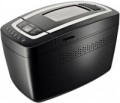Power
Rated power of the breadmaker.
This parameter is closely related to capacity (see "Maximum baking weight"): the higher bread weight inevitably require more power to heat efficiently. At the same time, models of the same capacity may have different power. In this case, the more powerful device will cope with its task faster, but will consume more energy and, most likely, will cost more.
Number of programs
The number of recipes and special programs (raw dough, jam, yogurt, etc.) provided in the bread machine. The larger this number, the more advanced this model is, the wider its capabilities. On the other hand, extensive functionality significantly affects the price. It is also worth considering that a specific set of programs in different models may be different; so when buying it is worth specifying not only the number of cooking modes, but also their specific list.
Additional programmes
—
Cake. The programme is designed for baking sponge cakes. Working according to the Cake programme, the bread machine creates optimal conditions for the sponge to rise well and acquire a soft porous structure.
—
— Jam. Due to the possibility of mixing and heating the product in the working chamber of the bread machine, many models allow you to cook not only bread, but also jam. For this, a special temperature regime is provided, in which more useful substances are stored than during conventional cooking over an open fire.
—
Dough kneading. Programme for preparing raw dough, without subsequent baking. It is useful if you plan to cook food outside the bread machine — for example, you can make dough for pies, dumplings, etc.
—
Pasta. Special kneading programme for hard dough for making homemade pasta. It is found mainly in advanced models of bread machines. Allows you to knead a thicker dough than for bread.
—
Pizza.... Kneading dough as a base for pizza. The programme involves compliance with a certain recipe using yeast cultures.
— Yogurt. Programme for making yogurt at home. Milk and starter culture are loaded into the working chamber of the bread machine, after which the optimal temperature regime is maintained there for the vital activity of beneficial lactic acid bacteria.
— Cream butter. In some bread machines, it is possible to use a stirrer to whip butter from milk, cream or sour cream. The presence of such a feature is useful, in particular, because the ingredients for making butter do not have to be fresh — thus, you can buy fresh sour cream for eating, and use it for butter after standing for a while.Number of blades for kneading
Most breadmakers are equipped with one blade for kneading dough — this is enough to prepare dough for bread weighing up to 1 kg inclusive. Models that allow you to bake larger loaves (starting from 1200 g) are often equipped with two kneading blades. In addition to the fact that the
two blades allow you to cook dough with a larger weight, they also provide a faster and more uniform kneading. However, an additional blade, usually, affects the price of the device.
Surge protection
The time during which the protection from voltage surges is active.
Many modern bread makers are equipped with such protection; during power surges it disconnects the device from the mains and suspends the programme, and when the voltage stabilizes, it starts it from the place where it stopped. The protection time is the time during which programme data can be stored in the memory of the bread maker after the protection is activated and the external power is turned off. If during this time the voltage has not leveled off and the power has not turned on, the programme is reset and the process must be started over. Thus, the longer the time specified in this paragraph, the more advanced the protection is, the lower the likelihood that the programme will have to be restarted in case of mains failures. In some models, the protection time can be up to 60 minutes.

